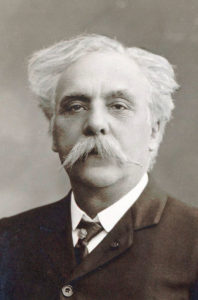Fauré, Piano Trio, Op. 120

Gabriel Fauré (1845-1924) attended a boarding school for musicians with a conservative focus on church music and turning out good organists and choirmasters. During his time there, Camille Saint-Saëns took over the piano instruction, and opened his students ears to the forbidden fruit, the music of modern Romanticism. Saints-Saëns remained Fauré’s mentor and strongest influence.
Upon completion of his studies, he held a series of jobs as church organist or choirmaster under Saints-Seans and Charles-Marie Widor, leaving him little time for composing. After Fauré’s engagement was broken off in 1877, Saints-Saëns took him to Weimar to visit Franz Liszt. (Yes, everybody, it seems, came to our adopted city of Weimar at some point.) There he was immersed in the music of Liszt and Wagner, although his music shows little of their influence. It was at about this time that he began composing his most famous work, the Requiem, Op. 48.
In 1896, he was appointed to the Paris Conservatory where he would teach the next generation of luminaries such as Maurice Ravel and Nadia Boulanger. He was named to head the conservatory in 1905 and embarked on a course of reforming the institution and opening it up to a greater variety of styles.
Fauré composed his piano trio late in life after his retirement from the Paris Conservatory. He wrote to his wife that he was working on a trio for piano, cello, and clarinet, but the work was published with the standard instrumentation of piano, cello, and violin. Whether Fauré discarded the idea of using clarinet is not clear, but the substitution of clarinet for violin in this performance has some legitimacy.
The work is very lyrical with melodies evoking a folk style. The last movement is in the form of a rustic dance.



